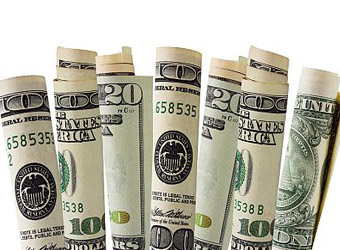Dollar prices inched up against a basket of its peers on Thursday after data shed more positive light on the U.S. economy, although sagging Treasury yields tempered the greenback’s gains.
The dollar index against a group of six major currencies was 0.05 percent higher at 93.500. It had declined 0.1 percent the previous day as speculation that the next head of the Federal Reserve could be a less hawkish candidate than expected knocked it off seven-week highs.
The greenback managed to crawl back after Wednesday’s data showed U.S. service sector growth hit is fastest in 12 years in September and private employers added more jobs than forecast despite Hurricane Harvey and Irma.
The gains, however, were kept in check with Treasury yields having pulled back from three-month peaks.
“The dollar has not been able to take full advantage of the latest series of strong U.S. data as Treasury yields have come down from their peaks,” said Junichi Ishikawa, senior forex strategist at IG Securities in Tokyo.
The dollar index had scaled the seven-week peak of 93.920 on Tuesday, when the 10-year Treasury yield hit the three-month high of 2.371 percent after strong U.S. manufacturing data hardened expectations for the Fed to raise interest rates by year-end.
The 10-year Treasury yield last stood at 2.328 percent.
“It appears that the market has mostly priced in dollar-positive factors, like better indications for the U.S. economy, tax-related issues and the likelihood of policy tightening by the Fed,” said Masashi Murata, senior currency strategist at Brown Brothers Harriman in Tokyo.
Improving U.S. data along with the prospect of U.S. tax cuts and the likelihood that the Fed will raise interest rates in December have boosted the U.S. currency in recent weeks.
“This leaves the dollar less responsive to positive factors, although it could show a relatively big reaction to negative surprises,” Murata at Brown Brothers Harriman said.
The euro was a shade lower at $1.1757 after gaining about 0.1 percent overnight.
The immediate focus was on the minutes of the European Central Bank’s (ECB) September policy meeting due later in the global day.
The ECB signalled at the meeting that while it could announce a plan this month for a gradual exit from its very easy monetary policy, it was in no hurry to end it.
The central bank also mentioned the potentially negative aspects of a strong euro at the September policy meeting so the markets will look closely at the minutes to gauge what was discussed about the currency.
After touching 112.920 yen early in the day the dollar was effectively flat at 112.740 after slipping to as low as 112.320 on Wednesday.
The Australian dollar was down 0.4 percent at $0.7832 after data showed the country’s retailers suffered their worst sales decline since early 2013 in August.
The Aussie moved back towards $0.7785, a near three-month low plumbed on Tuesday after the Reserve Bank of Australia cautioned that a higher currency would be a drag on the economy and inflation. Source: Reuters
Source: Reuters
